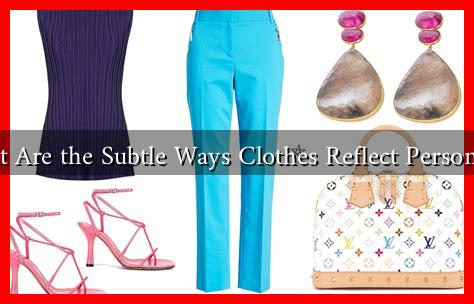-
Table of Contents
What Are the Subtle Ways Clothes Reflect Personality
Clothing is more than just a means of protection against the elements; it serves as a powerful form of self-expression. The way we dress can reveal a great deal about our personalities, values, and even our emotional states. This article explores the subtle ways in which clothing reflects personality, backed by research, examples, and insights from psychology and fashion studies.
The Psychology of Clothing Choices
Research in psychology suggests that our clothing choices are often influenced by our self-perception and the image we wish to project to the world. According to a study published in the journal *Social Psychological and Personality Science*, individuals often choose clothing that aligns with their self-identity. This means that what we wear can be a reflection of our inner selves.
Color Psychology
Colors play a significant role in how we perceive ourselves and how others perceive us. Different colors evoke different emotions and associations:
- Red: Often associated with passion, energy, and confidence.
- Blue: Conveys calmness, trustworthiness, and reliability.
- Black: Represents sophistication, power, and elegance.
- Yellow: Associated with happiness, optimism, and creativity.
For instance, a person wearing bright colors may be perceived as outgoing and cheerful, while someone in darker shades might be seen as more serious or reserved. This color psychology can significantly influence first impressions and social interactions.
Fashion as a Social Indicator
Clothing can also serve as a social indicator, reflecting not just personal style but also social status, cultural background, and group affiliation. The concept of “social signaling” suggests that our clothing choices can communicate our belonging to certain social groups or subcultures.
Case Studies in Fashion and Identity
Consider the following examples:
- Streetwear: This style often reflects urban culture and youth identity. Brands like Supreme and Off-White have become symbols of status among younger generations.
- Business Attire: In corporate environments, formal clothing can signify professionalism and authority. A well-tailored suit may convey competence and ambition.
- Casual Wear: The rise of athleisure reflects a shift towards comfort and practicality, often associated with a more relaxed lifestyle and a focus on health and wellness.
These examples illustrate how clothing can serve as a visual language, communicating complex social messages without a single word being spoken.
Personal Style and Individuality
While clothing can reflect broader social trends, it also allows for personal expression. Individual style is often a blend of various influences, including cultural background, personal experiences, and even mood. The concept of “personal branding” has gained traction, especially in the age of social media, where individuals curate their online presence through their clothing choices.
Statistics on Clothing and Self-Expression
A survey conducted by the fashion retailer *ASOS* found that:
- 70% of respondents believe that their clothing choices reflect their personality.
- 65% feel more confident when wearing clothes that align with their personal style.
- 58% use fashion as a way to express their individuality.
These statistics highlight the importance of clothing as a tool for self-expression and confidence-building.
Conclusion: The Language of Clothing
In conclusion, clothing serves as a subtle yet powerful reflection of personality. From color choices to fashion trends, what we wear communicates our identity, values, and social affiliations. Understanding the psychology behind our clothing choices can enhance our self-awareness and help us make more intentional fashion decisions. As we navigate the complex world of fashion, it’s essential to remember that our clothing is not just fabric; it’s a language that speaks volumes about who we are.
For further reading on the psychology of fashion, consider exploring resources like the *Fashion Institute of Technology* or the *Journal of Fashion Marketing and Management*.


